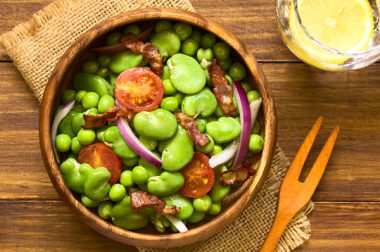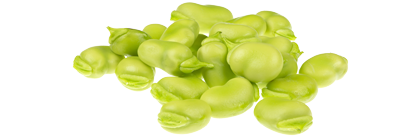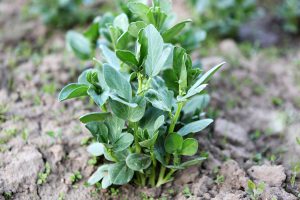Health
benefits
A vegetable to fill you up
Like all pulses, fava beans are high in fiber and protein. Because of these properties, fava beans make for nourishing dishes that limit snacking between meals.
They also contain:
- iron
- potassium
- phosphorus
Fava beans are also:
- a source of vitamin B9 (for cellular renewal, particularly important for pregnant women for fetal development, for growing children, and for convalescents).
- a source of vitamin B3 (for energy, the nervous system, skin health, and fatigue reduction).
- a source of vitamin B5 (for cognitive performance, energy, vitamin D synthesis, and fatigue reduction).
- a source of vitamin C (for the immune system, collagen formation, energy, the nervous system, iron absorption, and fatigue reduction).
Nutritional
composition
When is the right time to eat them?
April to July..
The fava bean season is short! Fava beans, an annual crop, are only available in springtime and early summer, from April to July.
Vegetable patch
or urban balcony?
Fava beans are an annual crop that grows in temperate regions. They grow in cool, deep soil rich in lime and clay, in sunny spots.
To learn everything you need to know about growing fava beans, read the page on growing advice.
Choosing
and storing fava beans
Choose your fava beans well:
- Fresh: they should be green and firm, without spots.
- Dried: they should be hard and smooth, and should break cleanly.
Properly store your fava beans:
- In the refrigerator: Two to three days at most in the vegetable drawer.
- In the freezer: blanch fresh fava beans for a few minutes and plunge them into ice water before freezing them.
- Away from light: in a sealed container for one year, for dry beans.
Tips
and tricks
How to cook fava beans
You have to earn your fava beans! You will lose a lot of fava beans, especially fresh ones, during preparation, so be sure to buy enough. And for dry beans, you need time!
Fresh fava beans: Prepare them right before using them in a recipe. After shelling them, ideally they should be blanched for a few minutes, and then submerged in ice water to easily remove the white, inedible skin that covers them.
Dry fava beans: they first need to be soaked overnight in cold water to be rehydrated. Then cook them for 45 to 90 minutes, according to their size.
Cooking times:
For fresh fava beans:
- 5 mins: steamed, in a pressure cooker, sautéed, or in a wok
- 15 mins: in boiling water
Fava beans go well with…
Raw: Small fava beans are more tender and can be eaten raw, with a bit of olive oil and salt or with a vinaigrette. Fava beans are a great addition to all salads and go well with tomatoes, avocados, cucumbers, and radishes.
Cooked: They are delicious puréed, with grilled fish or other seafood, in omelets, in stews, with duck or lamb, with couscous, cooked in a pilaf, or simply sautéed and seasoned generously with lemon juice and cilantro.
In Spain, they are used in fabada, a kind of stew, while in Italy they are cooked alla pancetta, with onions and bacon. In the Middle East, they are eaten in purées, fritters, and salads.
Can everyone eat them?

Young children
Children can eat them starting at 12 months of age. They can first try them in purée form, and older children will love them raw with bread and a little butter.
And everyone else.
People with favism, a form of anemia, should avoid eating broad beans because this pathology is set off by digesting these beans or inhaling pollen from the plant. Ask a health professional for advice.
Are you vegetarian? To have complementary proteins to make up for the absence of animal proteins, eat fava beans with grain products (bread, pasta, rice, couscous, etc.).
See plenty of other tips for encouraging children to eat vegetables
Where do they come from?
Origins and varieties
Origins
The main fava bean producers are China, Ethiopia, Egypt, Australia, and Spain.
Varieties
Fava beans, from the Fabaceae family, come in several varieties:
- The Aquadulce, with a very long pod that holds eight to nine seeds.
- The Seville, an early and productive crop, whose pod holds six seeds.
- The Précoce d’Aquitaine, one of the rarer varieties.



 Carott
Carott  Pumpkin
Pumpkin  Vegetable garden: growing green cabbage
Vegetable garden: growing green cabbage 










